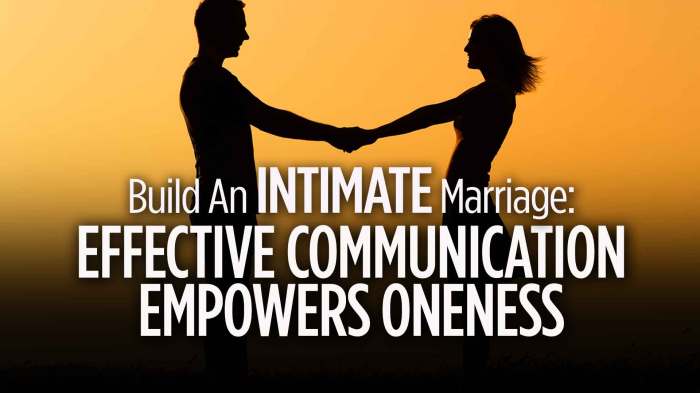Effective Communication in Marriage: Building a Stronger Bond

Effective communication in marriage is the cornerstone of a fulfilling and lasting relationship. It’s more than just exchanging words; it’s about creating a safe space where both partners feel heard, understood, and valued. This journey involves navigating the intricacies of expressing needs and feelings, resolving conflicts constructively, and fostering intimacy through meaningful conversations.
This guide delves into the fundamental principles of effective communication in marriage, exploring how to overcome common barriers, develop healthy communication habits, and navigate difficult conversations with empathy and understanding. By embracing the power of open and honest dialogue, couples can strengthen their bond, deepen their intimacy, and build a stronger foundation for a happy and fulfilling marriage.
The Foundation of Effective Communication: Effective Communication In Marriage

A strong foundation of communication is crucial for a successful marriage. It allows partners to build a deeper connection, understand each other’s perspectives, and navigate life’s challenges together.
Open and Honest Communication
Open and honest communication is the cornerstone of a healthy marriage. It involves sharing thoughts, feelings, and experiences freely and openly, without fear of judgment or criticism. When couples are open and honest with each other, they create a safe space for vulnerability and emotional intimacy.
This allows them to express their needs, desires, and concerns without holding back.
Active Listening
Active listening is a crucial skill in effective communication. It involves paying full attention to your partner, not just hearing their words but also understanding their emotions and intentions. Active listening requires:
- Maintaining eye contact
- Asking clarifying questions
- Summarizing what you’ve heard
- Avoiding distractions
Active listening demonstrates that you value your partner’s perspective and are genuinely interested in what they have to say. It fosters understanding, empathy, and a stronger emotional connection.
Communication Barriers
Several common barriers can hinder effective communication in marriage. These include:
- Defensive Communication: When a partner feels attacked or criticized, they may become defensive, leading to arguments and misunderstandings.
- Mind Reading: Assuming you know what your partner is thinking or feeling without asking can lead to misinterpretations and frustration.
- Stonewalling: Withdrawing from the conversation or refusing to engage can create a sense of distance and resentment.
- Criticism: Focusing on negative aspects of your partner’s behavior or personality can damage their self-esteem and hinder communication.
Overcoming Communication Barriers
Proactive communication strategies can help overcome these barriers:
- “I” Statements: Expressing your feelings and needs using “I” statements can help avoid blame and defensiveness. For example, instead of saying “You always forget to take out the trash,” try “I feel frustrated when the trash isn’t taken out.”
- Active Listening: Practicing active listening helps to understand your partner’s perspective and reduces misunderstandings.
- Timeouts: Taking a break from a heated conversation to calm down and gather your thoughts can prevent escalation and allow for more constructive dialogue.
- Empathy: Trying to understand your partner’s perspective, even if you don’t agree with it, can foster understanding and compassion.
Developing Healthy Communication Habits

Effective communication is a cornerstone of a strong and fulfilling marriage. It involves more than just exchanging words; it’s about understanding each other’s perspectives, needs, and feelings. Building healthy communication habits takes effort and intentionality, but the rewards are immense.
Expressing Needs and Feelings Assertively
Assertive communication is a vital skill in any relationship, especially marriage. It allows you to express your needs and feelings clearly and directly, without resorting to blame or criticism. Assertive communication fosters respect, understanding, and a sense of partnership.
- Focus on “I” Statements: Instead of blaming your partner (“You always forget to take out the trash”), use “I” statements to express your feelings and needs (“I feel frustrated when the trash isn’t taken out, and I would appreciate it if we could work together to ensure it gets done”).This approach shifts the focus from accusations to personal feelings and needs.
- Use “I” Statements to Communicate Personal Perspectives Effectively: “I” statements help to avoid placing blame and promote understanding. For example, instead of saying “You never listen to me,” try “I feel unheard when I share my thoughts, and I would appreciate it if you could listen attentively.” This approach emphasizes your feelings and needs, encouraging a more open and respectful dialogue.
- Avoid Harsh Language: Criticism and blame often lead to defensiveness and conflict. Instead of saying “You’re always late,” try “I feel anxious when you’re late because I worry about what might have happened.” This approach focuses on your feelings and the impact of your partner’s behavior on you.
- Use “I” Statements to Communicate Personal Perspectives Effectively: “I” statements help to avoid placing blame and promote understanding. For example, instead of saying “You never listen to me,” try “I feel unheard when I share my thoughts, and I would appreciate it if you could listen attentively.” This approach emphasizes your feelings and needs, encouraging a more open and respectful dialogue.
Communication Plan
Creating a communication plan can be a valuable tool for fostering open and regular dialogue. It provides a structured approach to ensure you prioritize communication and create opportunities for connection.
- Schedule Regular Check-Ins: Dedicate a specific time each week or month for intentional conversations. This can be a dedicated “date night” or a simple 15-minute check-in during the week. The key is to create a consistent space for open and honest dialogue.
- Create a Safe Space: Ensure that the communication plan includes a safe and comfortable environment for both partners to share their thoughts and feelings without judgment or fear of reprisal.
- Focus on Active Listening: Encourage active listening during check-ins. This means paying full attention to your partner, asking clarifying questions, and reflecting on what they’ve shared. This demonstrates respect and helps to ensure that both partners feel heard and understood.
Respecting Communication Styles
Every individual has a unique communication style and preferences. Recognizing and respecting these differences is crucial for effective communication in marriage.
- Identify Each Other’s Styles: Are you both verbal communicators, or does one of you prefer non-verbal cues? Do you both like to talk things out or does one of you need time to process their thoughts before sharing? Understanding these differences can help you adjust your communication approach accordingly.
- Avoid Making Assumptions: Don’t assume that your partner understands what you’re trying to say just because you’ve said it. Ask clarifying questions to ensure you’re on the same page. This demonstrates respect for your partner’s understanding and prevents misunderstandings.
- Be Open to Learning: Be willing to learn about your partner’s communication style and adjust your own as needed. This shows flexibility and a commitment to understanding each other. It also creates a space for growth and development in your communication.
Navigating Difficult Conversations
In the tapestry of marriage, disagreements are inevitable. While they can be challenging, they also offer opportunities for growth and deeper understanding. Navigating these conversations constructively requires a combination of empathy, communication skills, and a willingness to compromise.
Resolving Conflicts Constructively
Constructive conflict resolution involves open and honest dialogue aimed at finding mutually acceptable solutions. This requires active listening, expressing needs and feelings clearly, and focusing on the issue at hand rather than personal attacks.
- Active Listening: Pay attention to your partner’s words, tone, and body language. Seek to understand their perspective, even if you don’t agree. Avoid interrupting and focus on understanding before responding.
- “I” Statements: Express your feelings and needs using “I” statements, such as “I feel hurt when you…” or “I need…” This avoids blaming and encourages a more collaborative approach.
- Focus on Solutions: Instead of dwelling on the problem, brainstorm solutions together. Consider different perspectives and work towards a resolution that meets both your needs.
Approaching Sensitive Topics with Empathy and Understanding
Sensitive topics require a delicate approach. Empathy and understanding are crucial for navigating these conversations without causing further hurt or resentment.
- Choose the Right Time and Place: Avoid discussing sensitive topics when either of you is stressed, tired, or distracted. Find a time and place where you can have a calm and focused conversation.
- Validate Your Partner’s Feelings: Even if you don’t agree with their perspective, acknowledge and validate their emotions. Saying something like “I understand you’re feeling frustrated” can go a long way in creating a safe space for dialogue.
- Use “I” Statements and Focus on Needs: Express your feelings and needs in a way that doesn’t blame or attack. For example, instead of saying “You never listen to me,” try “I feel unheard when I try to share my thoughts.”
Taking Breaks During Intense Conversations, Effective communication in marriage
Intense conversations can escalate quickly. Taking breaks allows both partners to cool down, gather their thoughts, and approach the conversation with a calmer perspective.
- Recognize Signs of Escalation: Pay attention to your own emotions and your partner’s body language. If you notice signs of anger, frustration, or defensiveness, it’s time to take a break.
- Agree on a Time to Reconvene: Set a specific time to resume the conversation once you’ve both had a chance to calm down. This avoids leaving the issue unresolved and allows for a more productive discussion.
- Use the Break Wisely: Engage in activities that help you relax and de-stress, such as taking a walk, listening to music, or engaging in a hobby. Avoid dwelling on the issue or engaging in negative self-talk.
Practicing Forgiveness and Moving Forward
Forgiveness is essential for healing after disagreements. It doesn’t mean condoning the behavior but rather choosing to release the anger and resentment that can hold you back.
- Understand the Importance of Forgiveness: Holding onto anger and resentment can damage your relationship and your well-being. Forgiveness allows you to move forward and rebuild trust.
- Communicate Your Forgiveness: Let your partner know that you’ve chosen to forgive them. This can be a powerful step in healing and moving forward.
- Focus on the Future: After forgiveness, focus on rebuilding your relationship. Talk about how you can avoid similar conflicts in the future and work together to create a stronger and more loving bond.
The Power of Nonverbal Communication

In the tapestry of marital communication, words paint vibrant strokes, but nonverbal cues add subtle nuances that enrich the masterpiece. Nonverbal communication, encompassing body language, tone of voice, and facial expressions, plays a crucial role in conveying emotions, intentions, and underlying messages.
It’s a silent language that speaks volumes, influencing how partners perceive and interpret each other’s messages.
Understanding Nonverbal Cues
Nonverbal cues are powerful because they often convey information that words cannot express. They can be subtle or overt, conscious or unconscious, but they always hold meaning. By recognizing and understanding these cues, couples can deepen their connection and navigate communication more effectively.
Body Language
Body language is a rich tapestry of gestures, postures, and movements that reveal a person’s emotional state and intentions. For example, crossed arms might signal defensiveness, while a relaxed posture can indicate openness and receptivity. Eye contact is particularly significant in communication, conveying interest, sincerity, and connection.
However, it’s essential to consider cultural differences in interpreting body language, as certain gestures may have different meanings in different cultures.
Tone of Voice
The way we speak, including our pitch, volume, and rhythm, can significantly alter the meaning of our words. A warm, gentle tone can convey love and affection, while a harsh or sarcastic tone can create distance and tension. For instance, saying “I love you” in a monotone voice might not have the same impact as saying it with warmth and tenderness.
Paying attention to tone of voice can help couples understand the underlying emotions behind their partner’s words.
Facial Expressions
Our faces are expressive canvases that reveal a myriad of emotions. A smile can indicate happiness, while a frown can express sadness or disapproval. Even subtle changes in facial expressions, such as a raised eyebrow or a slight tightening of the lips, can convey important information.
Being attuned to these expressions can help couples understand their partner’s emotional state and respond appropriately.
Interpreting Nonverbal Signals
Interpreting nonverbal signals effectively requires sensitivity, empathy, and an understanding of your partner’s unique communication style. It’s essential to consider the context of the interaction, as well as the individual’s personality and cultural background. For example, a partner who is typically expressive might be more reserved in certain situations, while a partner who is typically reserved might become more animated when they are passionate about something.
Active Listening
Active listening is crucial for interpreting nonverbal signals. It involves paying attention to not only what your partner is saying but also how they are saying it. Observe their body language, facial expressions, and tone of voice, and try to understand the underlying emotions they are conveying.
This can help you gain a deeper understanding of their perspective and respond with empathy and sensitivity.
Seeking Clarification
If you are unsure about the meaning of a nonverbal signal, it’s okay to ask for clarification. You can say something like, “I noticed you seem a little tense. Is everything okay?” or “I’m not sure I understand what you’re trying to say.
Can you elaborate?” Asking for clarification demonstrates that you are paying attention and that you care about understanding your partner’s perspective.
Empathy and Validation
Empathy is essential for interpreting nonverbal signals accurately. Try to see things from your partner’s perspective and understand the emotions they are experiencing. Validation involves acknowledging and accepting their feelings, even if you don’t agree with them. For example, you might say, “I understand you’re feeling frustrated right now,” or “It sounds like you’re hurt by what happened.” Empathy and validation can help build trust and understanding in a relationship.
Aligning Verbal and Nonverbal Communication
To create a consistent and authentic message, it’s crucial to align your verbal and nonverbal communication. When your words and actions contradict each other, it can create confusion and mistrust. For example, saying “I’m fine” while rolling your eyes or sighing heavily can send a mixed message.
Mindful Communication
Mindful communication involves being aware of both your verbal and nonverbal messages. Before you speak, take a moment to consider what you want to convey and how your words and actions will be perceived. Are you communicating with warmth and respect, or are you being defensive or critical?
Being mindful of your communication can help you create a more harmonious and understanding relationship.
Nonverbal Feedback
Nonverbal feedback can reinforce or contradict your verbal messages. For example, nodding your head while listening to your partner can indicate that you are engaged and understanding. Maintaining eye contact can convey interest and respect. However, it’s important to be mindful of your nonverbal cues, as they can easily be misinterpreted.
For example, avoiding eye contact might be perceived as disinterest or dishonesty, even if that’s not your intention.
Self-Awareness
Self-awareness is essential for aligning verbal and nonverbal communication. Pay attention to your nonverbal cues and how they might be perceived by your partner. Are you using gestures that are open and inviting, or are you closed off and defensive?
Are you speaking with a warm and gentle tone, or are you being critical and harsh? By being aware of your nonverbal signals, you can make conscious choices to communicate more effectively.
Enhancing Intimacy and Understanding
Nonverbal communication can be a powerful tool for enhancing intimacy and understanding in a relationship. By being attuned to your partner’s nonverbal cues and responding with empathy and sensitivity, you can deepen your connection and build a stronger bond.
Touch and Physical Affection
Touch is a powerful form of nonverbal communication that can convey love, affection, and support. A gentle touch on the arm, a warm embrace, or a loving kiss can communicate volumes without saying a word. Physical affection can help couples feel connected, safe, and loved.
Shared Laughter
Laughter is a powerful nonverbal cue that can release tension, create a sense of connection, and enhance intimacy. Sharing laughter with your partner can help you bond, build memories, and enjoy each other’s company.
Nonverbal Gestures of Appreciation
Small gestures of appreciation, such as a loving glance, a thoughtful gift, or a simple “thank you,” can go a long way in conveying love and gratitude. These nonverbal cues demonstrate that you are paying attention to your partner and that you appreciate their efforts.
Conclusive Thoughts
In conclusion, effective communication in marriage is an ongoing process that requires dedication, patience, and a willingness to learn and grow together. By mastering the art of communication, couples can transform their relationship into a haven of love, understanding, and mutual respect.
Remember, communication is not just about words; it’s about creating a shared language of love and understanding that strengthens the bond between two hearts.
Comments are closed.